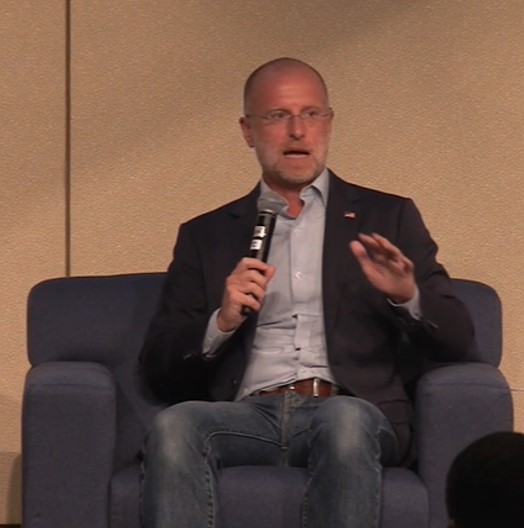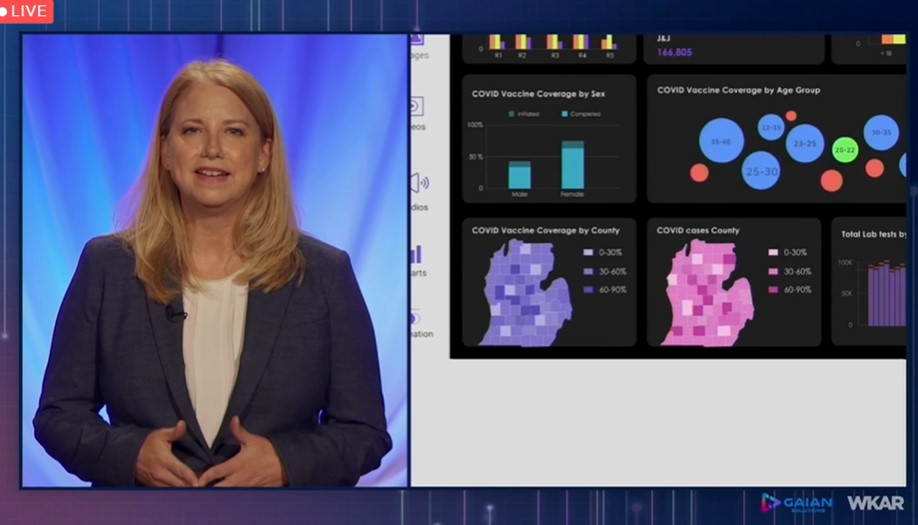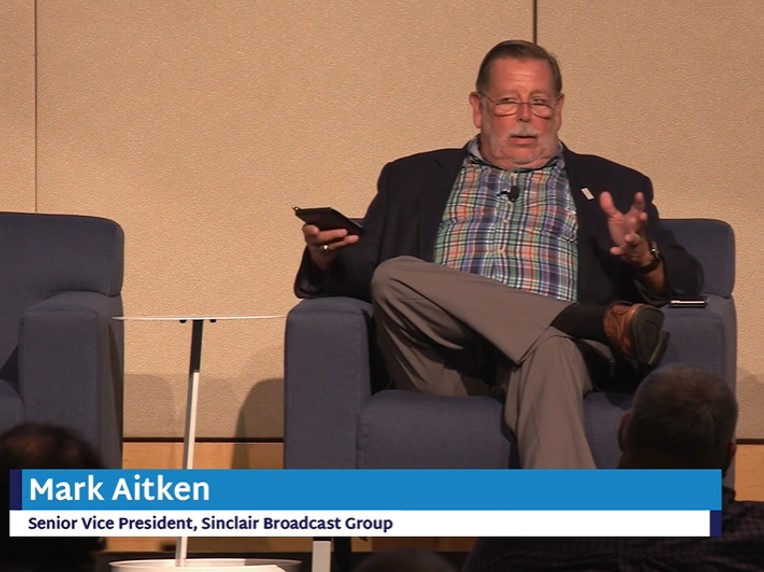Core Networks, Tower Connectivity, Broadcaster Education Vital for ATSC 3.0 Strength, Annual Confab Is Told
Sessions hear success stories as NextGen enters markets; Awards go to InterDigital's Stein, NAB's Smith
Advanced television's growing pains -- along with its growth trajectory -- were evident during this week’s ATSC "Full Steam Ahead" annual member meeting and conference. Discussions veered from NextGen TV's ability to make traditional broadcasting better to entry paths for entirely new data delivery ventures.

At the members-only session on Wednesday (Aug. 25), the focus was on the role of the core network, which "is going to be critical for IP datacasting," and operational issues such as "inter-tower communications network," Advanced Television Systems Committee President Madeleine Noland told Broadcasting + Cable. The next day's open conference looked toward evolving services, such as vehicular connectivity and regulatory oversight, offering a mixed collection of success stories and hopeful dreams.
And throughout the hybrid program (about 190 people in Washington’s Reagan Center plus about 90 others tuned into a live video stream), there was an upbeat "vibe" (as Noland called it) and a pep-rally motif as broadcasters and vendors encouraged each other with data about service launches and promising TV receiver sales forecasts that envision up to two million NextGen TV sets in homes with two years.
Nonetheless, "As we move into ATSC 3.0, the puzzle gets a lot harder," said ATSC Chairman Lynn Claudy, who is also senior VP technology at the National Association of Broadcasters.
"The notion of broadband service and data applications brings out a new set of industry players," Claudy acknowledged.
Also Read: NextGen TV’s Busy Summer Sets Up Fall Events
'Road Shows Are Back'
"This is about much more than standards development," Claudy added in his opening conference remarks. He pointed out that "standards development is still a core function," but insisted that a "standard is no good if no one understands it."
The smarter way to stay on top of broadcasting and cable industry. Sign up below
With that in mind, Claudy said, NAB will sponsor a series of at least five seminars around the country to show TV station business and technical executives how to implement ATSC 3.0 applications. The sessions will be "an all-day deep dive" into NextGen TV, reviving earlier NAB industry education projects. "Road shows are back," Claudy said.
The ATSC conference heard encouraging words from two Republican members of the Federal Communications Commission and field reports from pioneering NextGen TV ventures in Lansing, Michigan, Phoenix and elsewhere.
The core network "will supply the efficiency that will be necessary to provide services that will be attractive in the market place," Noland told B+C.
She characterized the inter-tower communications network as analogous to the studio-to-transmitter link, which she said might travel via microwave or fiber link. In the IP version, a broadcaster will have to "commit some of [its] own bandwidth to get data form one tower to another." She acknowledged that "STL is not cheap," but it "gives broadcasters another option" for their entry into the local data marketplace.
Noland noted that because there is line-of-sight, "You can get data between towers more efficiently and the equipment on the towers is professional quality," which will give broadcasters a near-term advantage "before MIMO [multiple-input and multiple-output] is available" on some other wireless networks. She cited the "tremendous efficiencies" of the broadcast structure.
Noland summed up the looming competitive battleground of data delivery: "If you want to win in the commodity market, you have to win on price and service." She said that broadcasters feel that their one-to-many use cases will appeal to customers in the evolving data delivery business.
Carr, Simington Explore Big Tech Competitive Role

Two Republican FCC commissioners took part in the ATSC conference. Commissioner Brendan Carr extolled the data opportunities of NextGen TV, saying that it “makes it easy to cellularize the broadcast signal” for a “broadcast internet” that will generate innovative applications. In an on-stage conversation with Noland, Carr encouraged TV stations to go “beyond the broadcast TV model,” citing opportunities in education.
In response to a question about the role of Locast (the over-the-air streaming service) and another proposal for dealing with multichannel video program distributors (MVPDs) streaming use of spectrum, Carr said, "I'm all for listening to how FCC can encourage facilities-based competition. I'm open to hearing ideas about how to make sure entities have fair access."
Carr said he favors an approach that enables "every one of these technologies get out there and compete" but acknowledged that, "we have to work through various bodies of law," including retransmission consent rules that focus on facilities-based competition.
The commissioner emphasized that NextGen TV developments "outside the usual broadcast silo" will be "huge," and he called the shift to the new technology "a very different transition" from the DTV migration more than a decade ago.
Carr also addressed the issue of how Big Tech (i.e., Silicon Valley companies) will compete with broadcasters' digital delivery plans. He cited the "imbalance" of broadcasters in the faceoff with "big tech" companies' communications' agendas, and he encouraged broadcasters to delve deeper into enabling disruptive technologies themselves.
"The FCC needs to adjust its approach to large tech companies," he said. Carr cited the need for Section 230 reform, but offered no specifics about his outlook.
Carr said that there is an "imbalance."
"There is a different treatment," he said. "We need to take a much stronger position of accountability." Asserting that tech companies "don't contribute" Carr suggested that for some of the spectrum issues, the Department of Homeland Security should lead and "we should work collaboratively," including communications industry involvement.
In one of the strangest attempts to duck a question about a timeline for FCC review of multicast rules, Carr said his staff had briefed him on the topic but he could not recall their information. He said there is no schedule for the timing of a decision.
"It is not clear to me the role of the FCC here," Carr said. "It has been consistently raised," but he said it has "been a while since I ran through the statutes."
Commissioner Nathan Simington, in a prerecorded video presentation, extolled NextGen TV as "broadcasting in the internet age" that will enable TV stations to expand their strength in localism. He cited the opportunities for broadcasters to "reclaim the targeting value proposition" by using IP technology, saying it lets "broadcasters double down this advantage as ATSC 3.0 rolls out."
Simington also encouraged broadcasters to explore NextGen TV's datacasting potential for services such as "simultaneous transmissions to thousands of devices" for automotive and navigation updates and other local services "that don't touch media consumption" but demonstrate the "resilient, reliable broadcasting infrastructure."
"I can't think of a better use of ATSC 3.0 technology than for next gen datacasting to supplement 5G tech," Simington said.
The Voices of Experience: Educational First

Susi Elkins, general manager WKAR Public Media and director of broadcasting at Michigan State University, offered a case study of NextGen TV applications from the viewpoint of a "customer's customer." Her presentation was supported by Gaian Solutions, Inc., which supplied the integrated digital Apollo Public TV Platform that WKAR has used for about two years.
Explaining how the station has used "a new ecosystem that recognizes the power of our over-the-spectrum capabilities," Elkins emphasized that NextGen TV serves as a "broadband pipe … [that] changes the paradigm." She demonstrated dynamic interactive features that the station has introduced for student education and campus engagement such as emergency alerts, some of which are integrated with 5G network features.
"This will fundamentally change the way we operate," Elkins explained. "Instead of sending audiences to our website, we can build that interactivity within our broadcast."
Sean D. Plater, general manager, WHUT-TV (licensed to Howard University in Washington, D.C.), also cited the importance of a campus emergency alert system. His station has been involved in a test of NextGen TV with a local middle school; Plater explained how the station "took a learning management system that Howard was using and put it on the platform" with "awesome" results so far.

Mark Aiken, senior VP, Sinclair Broadcast Group, which has also been involved in the Washington projects, cited the value of NextGen TV.
"IP Broadcast is not an add-on to the standard, it's at the core of the standard," Aitken said, pointing out that the services are "taking advantage of the file delivery facility that is at the core of this standard. We're leveraging those core features today." He also put in a plug for the chip (made by another Sinclair subsidiary) and the value of putting such a chip "into every handset to bridge the gap of the homes [that] don't have other internet connections."
Rob Folliard, senior VP, government relations and distribution, Gray Television, describing a field trial at one of Gray's stations, declared that "so much more can be done with unlimited multicast channels." He cited "advanced advertising, addressable advertising and … supporting the broadcast system in the future."
Awards to InterDigital's Alan Stein and NAB's Gordon Smith
ATSC ended the day's program by handing out its two annual awards for both 2021 and for last year (when the meeting and ceremony were virtual).
Alan Stein, VP of technology at InterDigital, received this year's Bernard J. Lechner Outstanding Contributor Award. The Mark Richer Industry Leadership Medal was awarded to NAB President/CEO Sen. Gordon Smith.

Stein, who heads InterDigital's Visual Standards Team, holds 16 granted patents in the field of digital video and oversees the company team involved with global video standards organizations. He has chaired ATSC's video group since its inception.
ATSC President Noland said that Smith, who is retiring as NAB chief, "understood the value that next-generation television could bring to the broadcasting industry and he was instrumental in promoting the potential to NAB's board and membership." NAB Chief Operating Officer Curtis LeGeyt, who will take over as NAB President in 2022, accepted the award for Smith.
"This technology gives broadcasters a compelling and interactive platform to tell our stories," LeGeyt said. "Our future is tied to developing standardized methods of innovation … to the ability to do something that's never been done before."
He added, "I commit to you that under my leadership, NAB will continue to push this important technology forward."
Contributor Gary Arlen is known for his insights into the convergence of media, telecom, content and technology. Gary was founder/editor/publisher of Interactivity Report, TeleServices Report and other influential newsletters; he was the longtime “curmudgeon” columnist for Multichannel News as well as a regular contributor to AdMap, Washington Technology and Telecommunications Reports. He writes regularly about trends and media/marketing for the Consumer Technology Association's i3 magazine plus several blogs. Gary has taught media-focused courses on the adjunct faculties at George Mason University and American University and has guest-lectured at MIT, Harvard, UCLA, University of Southern California and Northwestern University and at countless media, marketing and technology industry events. As President of Arlen Communications LLC, he has provided analyses about the development of applications and services for entertainment, marketing and e-commerce.

